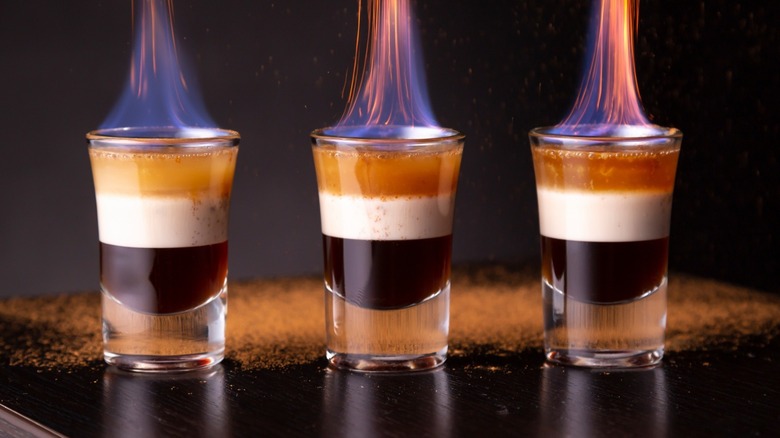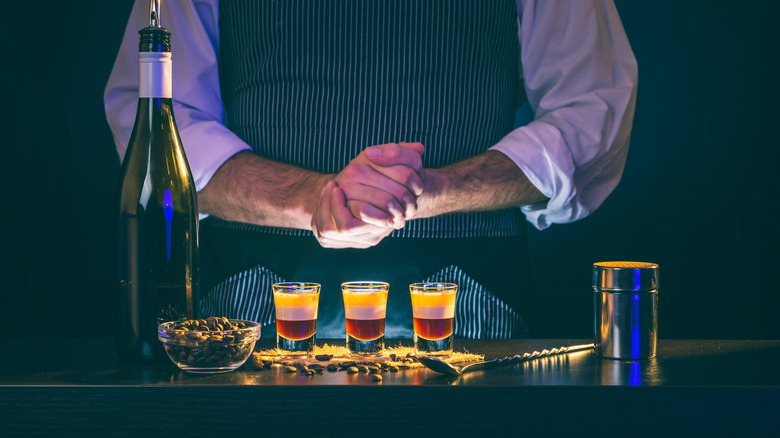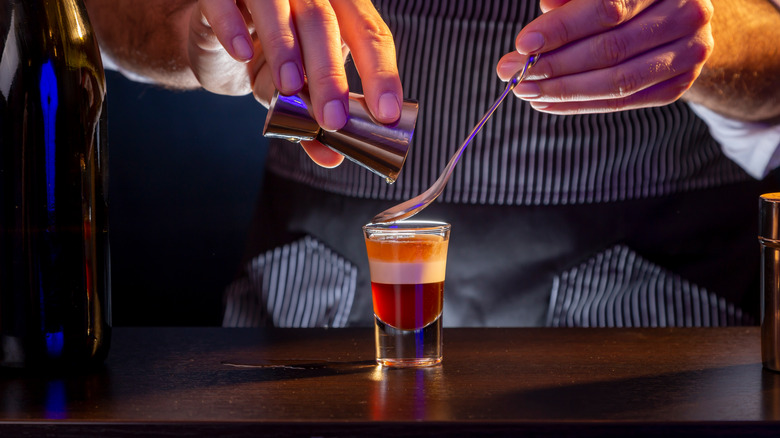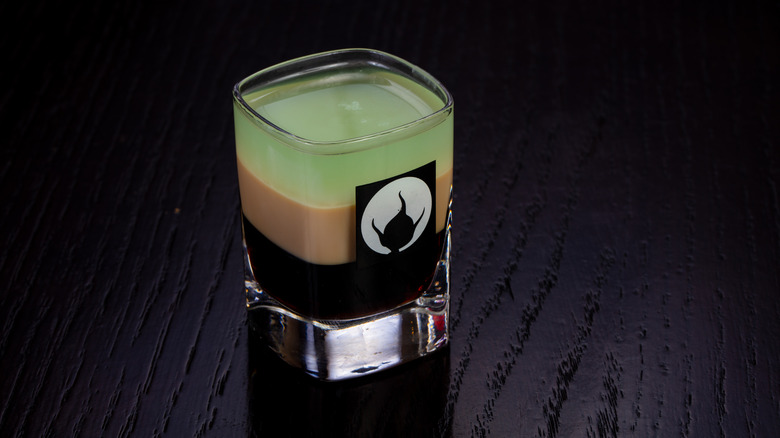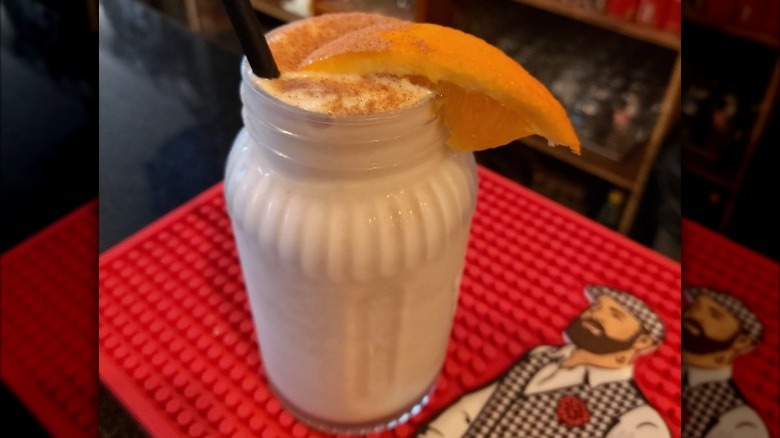What, Exactly, Is A B-52 Shot?
When we see the letter "B" followed by a number in a food context, we usually tend to think of something good for you: B6, B12, and the lesser-known B7, B9, and Bs 1 through 5 are all vitamins and some of these are essential nutrients. The B-52, on the other hand, isn't something that could be described as good for you by any stretch of the imagination. Not the original, which is a heavy bomber that debuted during the Vietnam War and is still part of the U.S. Air Force arsenal, and not its namesake cocktail, either.
Admittedly the B-52 shot is somewhat less lethal than its eponymous aircraft, but it's something you'll still need to watch out for if sugary booze is your poison. It consists of a triple dose of syrupy liqueurs: a coffee one such as Kahlua, an orange one like Triple Sec, and an Irish cream such as Bailey's. As such, it is not considered a shooter but a layered shot, since shooters typically contain non-alcoholic mixers whereas shots are all alcohol.
History of the B-52
The B-52 shot, which some bartenders may consider a "stunt drink" not too many steps up from a Jell-O shooter, is a direct descendant of the pousse-cafés that were popular in France back in the '60s — the 1860s. The B-52 itself, however, is a product of the 20th century. One origin story claims that the drink was created in Malibu, California, in the 1960s and named after the bomber, citing as corroborating evidence the fact that the orange liqueur is supposed to represent an aircraft that has gone down in flames. (Kind of grim, if you think about it, but there was a war on at the time.)
Another story dates the drink to 1977 and credits it to a Canadian bartender named Peter Fich who was said to have been a fan of the band that shares a name with both drink and bomber, although he'd have had to have been a pretty early adopter in this case as the new wave icons had their first tour that same year. No matter when it was invented or how it got its name, the B-52 seems to have had its heyday in the '90s. It was especially popular in college bars and frat houses during this era, perhaps because sweet drinks often serve as a gateway to alcohol for newbie drinkers who have yet to acquire a taste for the harder stuff.
How to make a B-52
If you want to make a B-52, it may require a certain amount of practice to nail down that perfect pousse-café pour. But wait, we're getting ahead of ourselves here. The first step is to select the ingredients. You may want to go for the cheapest generic cream, coffee, and orange liqueurs as you're likely to mess up a few batches of drinks before you get the layering technique down pat (although you can certainly still drink them). Still, some will insist on using only name brands such as Baileys, Kahlua, and Cointreau or the even fancier Grand Marnier. Choose whatever you can afford and are willing to drink, which is a basic rule of thumb that applies to any recipe.
Once you've lined up your three bottles o'booze, you'll also need a shot glass and a small spoon. If you have no bar spoon, a teaspoon will work just fine. Pour about a tablespoon of coffee liqueur into the glass, then put the spoon, bottom-side up, over the glass and slowly pour a tablespoon of cream liqueur over the top. The spoon will slow the pour even more so the second liqueur floats atop the first. Finish by pouring a tablespoon of orange liqueur over the spool. If you've managed to pull off the layering, take a moment to admire the drink (and photograph it, if you must). Whether you sip or slam the B-52, that's the last you'll see of the striation.
B-52 variations
The B-52 may be among the most popular of shots, and, as such, has spawned a whole host of knockoffs. Many of these adhere to the numerical naming convention, with a B51 using hazelnut liqueur in place of orange while one version of the B53 uses an anise-flavored liqueur such as Sambuca instead of the Irish cream while another replaces the orange liqueur with vodka. For a B54, amaretto takes the place of orange liqueur, while absinthe serves the same function in a B55. You can also drop the cream liqueur and sub in peppermint schnapps for a B-57 or make an F-16 by using rum instead of orange liqueur.
A few other B-52 variants know how to use their words: A B-52 With Bomb Bay Doors simply adds gin (Bombay, of course) to the basic drink, while a B-52 in the Desert uses tequila in place of cream liqueur. For a B-52 With a Full Pay Load, you make the drink, then add a layer of hazelnut liqueur and top it off with flaming rum (an overproof one if possible, since this kind is more flammable). A more standard variant is the flaming B-52, which omits the hazelnut but keeps the rum flambé. You can also go in the opposite direction and move from fire to ice by blending this latter element with the drink ingredients to make a frozen B-52.
B-52 nutrition
Needless to say, the B-52 isn't a health tonic -– in fact, the World Heart Federation has concluded after extensive study that no amount or type of alcohol really offers significant health benefits. On a drink-per-drink basis, though, the B-52 may not be quite as bad as you might imagine. A 1 ½-ounce drink, made from equal amounts of coffee, cream, and orange liqueurs, typically contains about 130 calories, which is admittedly higher than the 96 calories you'd find n a vodka soda made with a similar amount of that spirit. Unlike 40% ABV vodka, though, the combination of liqueurs in a B-52 is only about 26% alcohol.
The trouble with the B-52, as compared to a longer drink, is the fact that it's typically served as a shot, which can lead you to consume it too quickly. The faster you drink, the drunker you get, since your body can only metabolize so much alcohol at a time. One way to slow down the rate at which you consume your B-52 is to build it in a cocktail glass instead of a shot glass, even though doing so may tend to mess up the pretty layers to some extent. Still, those layers are ephemeral, whereas your liver is meant to last a lifetime. You could also toss some ice into the B-52 or just go ahead and make it into a blender drink since crushed ice will definitely slow down your sipping unless you're impervious to brain freeze.
